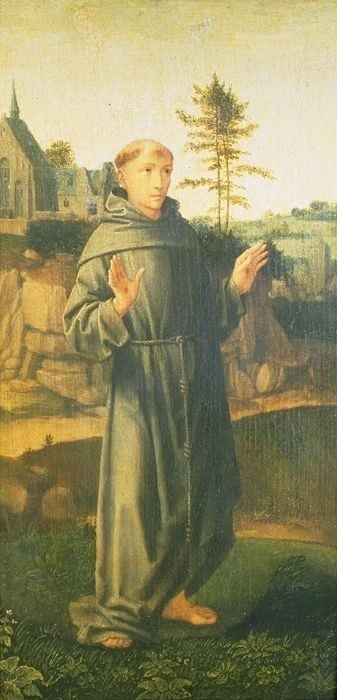 | ||
The anonymous text that is usually called the Prayer of Saint Francis (or Peace Prayer or Make Me an Instrument of Your Peace) is a widely known Christian prayer for peace. Often associated with the 13th-century Italian saint Francis of Assisi, but entirely absent from his writings, the prayer in its present form has not been traced back further than 1912. Its first known occurrence was in French, in a small spiritual magazine called La Clochette (The Little Bell), published by a Catholic Church organization in Paris named La Ligue de la Sainte-Messe (The League of the Holy Mass). The author's name was not given, although it may have been the founder of La Ligue, Father Esther Bouquerel. The prayer was heavily publicized during both World War I and World War II. It is frequently set to music by notable songwriters and quoted by prominent leaders, and its broadly inclusive language has found appeal with diverse faiths.
Contents
Text
In most of the published versions of the prayer, the text is abridged, paraphrased, and/or copyrighted. Below is the complete original text from its earliest known publication (1912, in French, copyright expired), alongside a line-by-line English translation:
A friar/historian has observed that the first half of the prayer is atypically self-centered for St. Francis. However, the second half has similarities to this saying of Blessed Giles of Assisi, one of the saint's companions:
Sebastian Temple (1967)
The most-prominent hymn version of the prayer is "Make Me a Channel of Your Peace", or simply "Prayer of St. Francis", adapted and set to a chant-like melody in 1967 by South African songwriter Sebastian Temple (Johann Sebastian von Tempelhoff, 1928–1997), who had become a third order Franciscan. The hymn is an anthem of the Royal British Legion and is usually sung at its annual Festival of Remembrance. In 1997 it was part of the Funeral of Diana, Princess of Wales, and was sung by Sinéad O'Connor on the Princess Diana tribute album. The hymn was also sung for the religious wedding ceremony of Prince Albert II of Monaco to South African Charlene Wittstock in 2011.
Others
Additional settings of the prayer by notable musicians include those by:
History
Christian Renoux, a history professor at the University of Orléans, published in French in 2001 a book-length study of the prayer and its origins, clearing up much of the confusion that had accumulated previously. The Vatican newspaper L'Osservatore Romano later published an article in Italian summarizing the book's findings, and Renoux published a brief online history in English at The Franciscan Archive.
La Clochette (1912)
The earliest known record of the prayer is its appearance, as "a beautiful prayer to say during Mass", in the December 1912 issue of the small devotional French Catholic publication La Clochette, "the bulletin of the League of the Holy Mass". Although the prayer was published anonymously, Renoux concluded that, with few exceptions, the texts in La Clochette were generally written by its founding editor, Father Esther Bouquerel (1855–1923).
Mistaken attribution to 11th-century William the Conqueror
In 1915, Marquis Stanislas de La Rochethulon, president of the Anglo-French association Souvenir Normand, which called itself "a work of peace and justice inspired by the testament of William the Conqueror, who is considered to be the ancestor of all the royal families of Europe", sent this prayer to Pope Benedict XV in the midst of World War I. The Pope had an Italian translation published on the front page of L'Osservatore Romano on 20 January 1916. It appeared under the heading, "The prayers of Souvenir Normand for peace", with a jumbled explanation: "Souvenir Normand has sent the Holy Father the text of some prayers for peace. We have pleasure in presenting in particular the prayer addressed to the Sacred Heart, inspired by the testament of William the Conqueror." On 28 January 1916, the French newspaper La Croix reprinted, in French, the article from L'Osservatore Romano, with exactly the same heading and explanation. La Rochethulon wrote to the newspaper to clarify that it was not a prayer of Souvenir Normand; but he failed to mention La Clochette, the first publication in which it had appeared. Because of its appearance in L'Osservatore Romano and La Croix as a prayer for peace during World War I, the prayer became widely known.
Mistaken attribution to 13th-century Saint Francis
Around 1916–1918, Father Étienne Benoît, a French Franciscan priest, printed the "Prayer for Peace", without attribution, on the back of a mass-produced holy card depicting the renowned peacemaker, Saint Francis. The prayer was circulating in the United States by January 1927, when its first known English version (not under any known copyright) appeared in the Quaker magazine Friends' Intelligencer under the misattributed and misspelled title "A prayer of St. Francis of Assissi". The saint's namesake American archbishop and military vicar Francis Spellman distributed millions of copies of the "Prayer of St. Francis" during World War II, and the next year it was read into the Congressional Record by Senator Albert W. Hawkes. As a friar later summarized the relationship between the prayer and St. Francis: "One can safely say that although he is not the author, it resembles him and would not have displeased him."
Other notable invocations
The Peace Prayer has often been cited with national or international significance:
